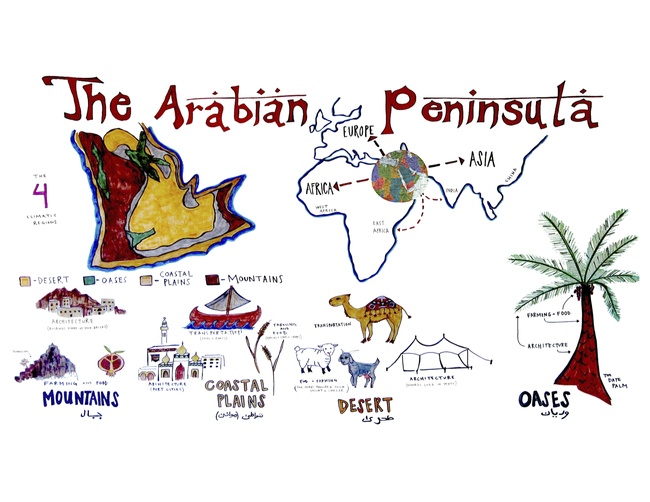Kitchen Humanities: Middle Eastern Meze Platter

Summary
In this 7th grade humanities lesson, students prepare a Middle Eastern meze platter using ingredients that represent the four climatic regions of the Arabian Peninsula.
Objectives
After this lesson, students will be able to:
- Identify the four climatic regions of the Arabian Peninsula crops native to each region
- Understand how the four climatic regions of the Arabian Peninsula affected food and farming in each region
- Refine knife skills and practice different cuts and sizes as needed
Assessments
During this lesson, students will:
- Answer questions about the climatic regions and foods of the Arabian Peninsula
- Describe the four climatic regions of the Arabian Peninsula and discuss their effects on food and farming
- Cut vegetables into sizes appropriate for dipping
Materials
For the Chef Meeting
- Tabbouleh recipe
- Hummus recipe
- Yogurt Sauce recipe
- Recipe ingredients and tools for demonstration
- Meze platter visual aid
- Meze platter notes
Ingredients
- Seasonal vegetables for crudités
- Dates
- Almonds
- Pomegranate
For the Tabbouleh
- Bulgur
- Flat leaf parsley
- Mint
- Lemons
- Olive oil
- Salt
- Pepper
For the Hummus
- Garbanzo beans
- Garlic
- Tahini
- Lemons
- Flat leaf parsley
- Salt
- Pepper
For the Yogurt Sauce
- Yogurt
- Radish, carrot, or cucumber
- Garlic
- Mint
- Salt
Tools
- Mixing bowls
- Reamer or juicer
- Grater
- Garlic peeler
- Mortar and pestle
- Wooden spoons
- Chef knives
- Paring knives
- Cutting boards
- Measuring beaker
- Measuring cups
- Measuring spoons
Equipment
- Blender or food processor
- Stove
Before You Begin
- Collect all the tools and ingredients, then distribute them to the tables
- Gather supplies for the Chef Meeting
- Create the visual aid
- Copy the Tabbouleh recipe to hand out
- Copy the Hummus recipe to hand out
- Copy the Yogurt Sauce recipe to hand out
- Soak the bulgur (one part bulgur to one part water)
- Cook the garbanzo beans
Procedures
At the Chef Meeting
- Welcome students and ask if they have heard of a meze platter. Explain that a meze platter is an assortment of appetizers and introduce the Tabbouleh, Hummus and Yogurt Sauce recipes.
- Locate the Arabian Peninsula on the visual aid and discuss its significance as a crossroads for trade between civilizations.
- Ask students to identify the four climatic regions of the Arabian Peninsula: desert, oases, coastal plains, and mountains. Review the connection between climate, geography and diet.
- Identify ingredients representative of each region of the Arabian Peninsula. Incorporate information from the notes (see resources).
- Explain that foods native to the Arabian Peninsula traveled via trade routes to become staple foods in other cultures.
- Introduce all the recipes and components of the meze platter.
- Ask students to wash their hands and join their table group.
At the Table
- Meet with the table groups and review the recipes.
- Demonstrate how to cut vegetables into a crudité.
- Assign cooking jobs.
- Prepare the recipes and set the table.
- Eat.
- Clean up.
At the Closing Circle
Ask each student to name one ingredient and its climatic region of origin.
Vocabulary
Crudités
Arabian Peninsula
Desert
Oasis
Coastal plains
Mountains